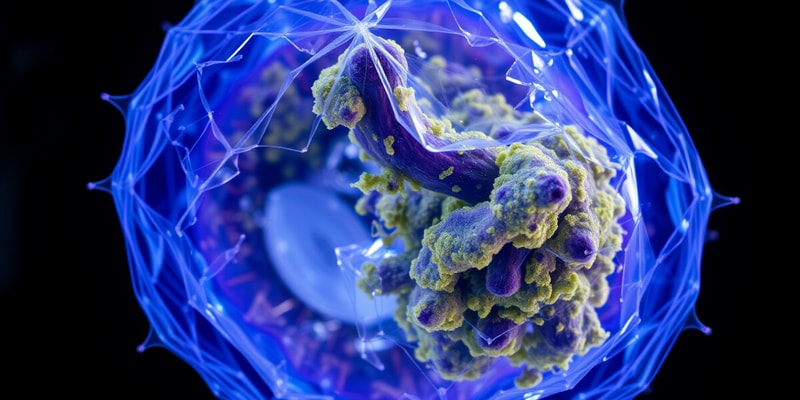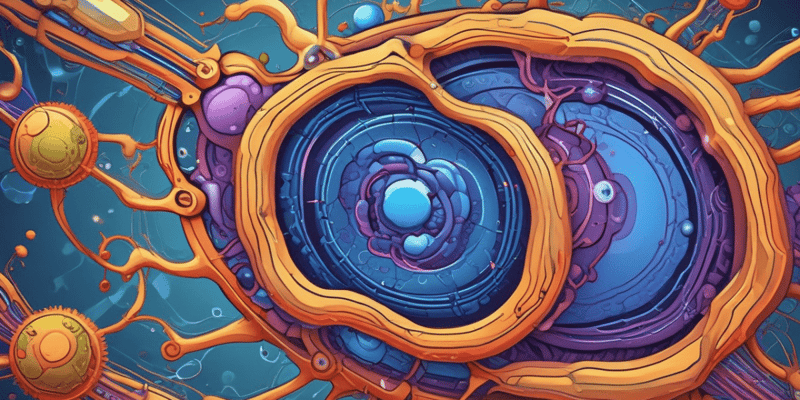Questions and Answers
Which statement accurately describes the role of the nucleus in a cell?
What is NOT a function of the plasma membrane?
What characterizes the cytoplasm within a cell?
Which of the following statements about mature red blood cells is true?
Signup and view all the answers
What is the primary function of the Golgi apparatus?
Signup and view all the answers
What distinguishes the role of mitochondria, often referred to as the 'powerhouses' of the cell?
Signup and view all the answers
What is the primary function of lysosomes within a cell?
Signup and view all the answers
Which statement accurately describes centrioles?
Signup and view all the answers
How do cilia primarily function on the surface of a cell?
Signup and view all the answers
What critical role does the cytoskeleton play in a cell?
Signup and view all the answers
Which of the following statements about epithelial tissue is true?
Signup and view all the answers
What distinguishes exocrine glands from endocrine glands?
Signup and view all the answers
Which of the following is a function of epithelial tissue?
Signup and view all the answers
Goblet cells are a specialized type of epithelial cell known for the secretion of:
Signup and view all the answers
What is the primary role of tight junctions in epithelial tissue?
Signup and view all the answers
What characterizes dense connective tissue?
Signup and view all the answers
Which type of cartilage is known for providing flexible support?
Signup and view all the answers
What is the primary function of adipose tissue?
Signup and view all the answers
Bone tissue is primarily made up of which type of cells?
Signup and view all the answers
Which connective tissue type has a fluid matrix that helps transport substances?
Signup and view all the answers
What type of muscle tissue is responsible for voluntary movements such as skeletal control?
Signup and view all the answers
Which type of muscle tissue is found exclusively in the heart?
Signup and view all the answers
What are the two types of cells found in nervous tissue?
Signup and view all the answers
Which type of muscle tissue is responsible for controlling involuntary bodily functions such as digestion?
Signup and view all the answers
Which characteristic is unique to skeletal muscle tissue compared to cardiac and smooth muscle?
Signup and view all the answers
What is the main characteristic of fibrosis in tissue repair?
Signup and view all the answers
Which of the following statements about regeneration is accurate?
Signup and view all the answers
Which type of tissue is primarily formed during the healing of severe cuts and burns?
Signup and view all the answers
What are the two main categories of membranes in the body?
Signup and view all the answers
What role do membranes play in the body?
Signup and view all the answers
Which of the following is NOT a characteristic of mucous membranes?
Signup and view all the answers
What role does serous fluid play in the body?
Signup and view all the answers
Which pair correctly matches the serous membrane with its corresponding organ?
Signup and view all the answers
Which statement correctly describes cutaneous membranes?
Signup and view all the answers
How does the parietal membrane differ from the visceral membrane?
Signup and view all the answers
What is the primary function of the hypodermis layer beneath the skin?
Signup and view all the answers
What condition is characterized by a yellow discoloration of the skin and eyes?
Signup and view all the answers
Which of the following conditions results in a pale appearance of the skin due to decreased blood flow?
Signup and view all the answers
What mechanism causes erythema, which is characterized by abnormal redness of the skin?
Signup and view all the answers
What is the significance of melanocytes within the epidermis?
Signup and view all the answers
What is the primary function of hair on the head?
Signup and view all the answers
Which type of melanin is primarily responsible for darker hair color?
Signup and view all the answers
What is NOT a function of the skin's barriers?
Signup and view all the answers
Which area of the body is least likely to have hair?
Signup and view all the answers
What role does vitamin D primarily play in the body?
Signup and view all the answers
Which layer of the cutaneous membrane is responsible for nutrient and gas exchange through diffusion?
Signup and view all the answers
What is a primary function of the dermis in the integumentary system?
Signup and view all the answers
What important role do sensory nerve receptors in the skin play?
Signup and view all the answers
Which of the following statements about the skin's appendages is correct?
Signup and view all the answers
Which statement is true regarding the epidermis?
Signup and view all the answers
Study Notes
Cells
- The human body contains over 100 trillion cells, with 3 billion cells dying and being replaced every minute.
- Cells are the fundamental unit of life, facilitating respiration, movement, reproduction, digestion, and excretion.
Nucleus
- Central control center of the cell, housing all genetic information.
- Most cells possess one nucleus, with mature red blood cells being an exception.
Plasma Membrane
- Enclosing layer of the cell that regulates substance passage, defining cell boundaries.
Cytoplasm and Organelles
- Gel-like substance filling the area between the plasma membrane and the nucleus.
- Organelles function as "little organs" within the cell.
Golgi Apparatus
- Receives proteins from the endoplasmic reticulum, preparing and packaging them for export.
Cell Components
- Centrioles: Located outside the nucleus, they assist in cell division.
- Mitochondria: Known as "powerhouses," they have double membranes and are more abundant in metabolically active cells.
- Lysosomes: Membranous vesicles from the Golgi apparatus that recycle cellular components and destroy bacteria, referred to as "cellular garbage disposals."
- Cytoskeleton: Provides structural support and maintains cell shape while allowing movement.
- Cilia: Hair-like structures that trap mucus and are found on cell surfaces.
- Flagella: Long whip-like structures, with the only human flagellum being the sperm tail.
Tissues
- Cells in the body are classified into four main tissue groups.
Epithelial Tissue
- Continuous sheet of tightly packed cells that covers surfaces, lines cavities, and forms glands.
- Functions include protection, absorption, filtration, and secretion, with tight junctions preventing substance leakage.
- Epithelia have a top surface exposed to the environment and a bottom surface attached to connective tissue through the basement membrane.
Glandular Epithelium
- Specialized epithelial cells that secrete specific substances.
- Exocrine Glands: Release products into ducts (e.g., sweat glands).
- Endocrine Glands: Ductless, secreting hormones directly into the bloodstream (e.g., adrenal, pituitary glands).
Connective Tissue
- The most diverse tissue type, connecting and supporting body structures.
- Four types: fibrous connective tissue, cartilage, bone, and blood.
Types of Connective Tissue
- Fibrous Connective Tissue: Includes loose (areolar, adipose, and reticular) and dense (tendons, ligaments).
- Cartilage: Flexible tissue with three types: hyaline (most common), elastic (external ear), and fibrocartilage (intervertebral discs).
- Bone: Composed of osteocytes within a mineralized matrix.
- Blood: Liquid connective tissue that transports cells and substances.
Nervous Tissue
- Composed of neurons and neuroglia, enabling rapid communication within the body.
Muscle Tissue
- Comprised of elongated cells capable of contraction, including:
- Skeletal Muscle: Voluntary muscles connected to bones, enabling movement.
- Cardiac Muscle: Involuntary, found only in the heart.
- Smooth Muscle: Involuntary, lining hollow organs and regulating bodily functions.
Tissue Repair
- Regeneration: Replacement of damaged cells with the same type, restoring functionality.
- Fibrosis: Replacement with scar tissue, which does not restore functionality.
Membranes
- Thin sheets of tissue serving vital functions such as lining cavities and covering surfaces.
- Types include epithelial membranes (mucous, cutaneous, and serous) and connective tissue membranes.
Cutaneous Membrane
- Consists of three layers: epidermis (outer, avascular), dermis (inner, vascular), and hypodermis (subcutaneous tissue).
Skin Color
- Determined by melanocytes scattered in the epidermis.
Abnormal Changes in Skin Color
- Cyanosis: Blue tint due to low oxygen.
- Jaundice: Yellow discoloration from liver dysfunction.
- Albinism: Lack of melanin, resulting in pale skin and hair.
- Erythema: Redness from increased blood flow.
- Pallor: Pale skin due to decreased blood flow.
- Bruise: Color changes from blood pooled under the skin.
Appendages of Skin
- Hair: Present everywhere except certain areas; provides insulation and traps debris.
- Hair Follicle: Epidermis sheath containing the hair root where hair growth occurs.
Skin Functions
- Protection, barrier, vitamin D production, sensory perception, and thermoregulation.
Vitamin D Significance
- Essential for calcium absorption, bone health, immune system function, and autoimmune disorder risk reduction.
Studying That Suits You
Use AI to generate personalized quizzes and flashcards to suit your learning preferences.
Description
Explore the fascinating world of cells in this quiz on Chapter 3 of Biology. Learn about the structure, function, and significance of cells, as well as the vital role of the nucleus as the cell's control center. Test your knowledge of the building blocks of life and their processes.



